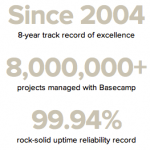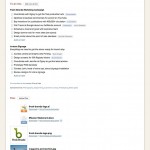
37Signals has recently launched a new version of Basecamp, their 8 year-old market-leading project management tool.
The new version is much more than a facelift: Basecamp has gone through major changes. But did it get any better?
Two weeks ago, I took part in a webinar presenting 37signals’ new version of Basecamp (codename: Basecamp Next).
This is a review post of the new version of Basecamp, after a week of playing around with it, and being a user of the original system for over 7 months.

For readers who are unfamiliar with Basecamp, it is a project management application (or service, or platform… choose your flavor).
By now, it has been already used to manage over 8,000,000 (eight million!!) projects, by companies from all around the world, including some S&P 500 companies (some more impressive statistics are available on the right of the screen).
I made a great effort last year to push Basecamp into my current workplace. It’s been a success ever since.
The greatest advantage of the original Basecamp was simplicity.
Unlike other programs and services in the field, Basecamp does not require you to be an alumnus of The Hogwarts School of Witchcraft And Wizardry in order to figure out how to use it.
For example, it only took me 30-40 minutes to train most of the personnel at my workplace and get them started.
Now that the new Basecamp is out, it’s time to see what has changed, what got better (or worse) and determine which version should you use – The New version, or the Classic one?
Before I start, I just want to make it clear: I am not an affiliate of 37signals. I get no gains from this post besides providing it as a service to my readers.
The New Basecamp: The Good
I just love the product. It made my work life better, and I think that many other people can benefit from it in similar ways.
Support
![]() The most important thing to know about 37signals, is that their support is mind-blowing. Of course, this is true for both New and Classic Basecamp versions.
The most important thing to know about 37signals, is that their support is mind-blowing. Of course, this is true for both New and Classic Basecamp versions.
The support staff are quick, kind, and helpful. They make sure that problems get solved. They care to get better and take note of the customer’s experience. They will tell you the honest truth, even if that means admitting that one of their developers has dropped the ball.
When I train support staff at my workplace, 37signals are my go-to example of how customer support should be handled. I actually sat my boss down and shown him 37signals’ support statistics, in order to persuade him that our company’s support can and should do much better.
Speed

Basecamp is now significantly faster. 37signals founders, Jason Fried and DHH claim it’s so fast, that it’s almost indistinguishable from desktop applications. So, Is it?
In one word – no.
In two words – No, BUT.
I have been testing it using a standard 2.5 ADSL connection, at my home in the Middle East. When factoring out the network latency caused by internet packets circling the globe -YES, it is VERY fast.
And the best part of it? DHH (37signals founder himself) publicly shared in great details the exact practices taken in order to achieve this improvement, educating the entire web developers community on how to get it right.
I hope that more and more developers will take notice, as Basecamp might just become the benchmark for similar applications in the near future. And I salute to DHH for taking the time to share and teach.
If you’re interested, here are the posts that DHH wrote about it:
Usability
Users of the classic Basecamp learned to live with a slightly cluttered system.
We had to-dos, to-do comments, messages, message comments, to-do lists, to-do list comments, events, event comments, and god knows what other variations.
This caused much confusion to our personnel. People just couldn’t figure it out. One always had to guess where a wanted discussion can be found. They didn’t even call it a discussion, as the phrase has only been coined in the new Basecamp!
Now, the clutter has been removed. The list of terms used in Basecamp had shrank dramatically. Complexity has vastly decreased. Focus is the new king.

The new Basecamp still has to-dos, to-do lists, events and files. But now, the same language is spoken across the board: When you post a comment on a to-do, you start a discussion. Same for to-do lists, events, files, and probably anything else that might be added later.
Now, all entities use the same terms, and all discussions are placed together and easily found on one single page – centralizing the whole project into one view (see next section – design – for more on this).
With much clearer language, Basecamp became one step simpler and easier to use. And the people rejoiced, Hooray! (to honor David Heinemeier Hansson’s native language, I’ll also add: Hurra!)
Design

I have two words for the new design. Clean. Focused.
All parts of the project are now visible on a single effective page.
No more tabs. Instead, items open and close on top of the main page – like piling up papers. Thus, you are always just one click away not only from your previous page, but also its context.
That’s it. Nothing to add.
Training
The Basecamp support staff currently offer an online guided tours to educate people on the new Basecamp and teach how to use it, including a live Q&A session. In the tour, you can get a glimpse of how Basecamp is used internally at 37signals. Interesting and fun!
I love the social proof that they are generating by requiring that all questions are posted on Twitter. Definitely a smart move. I’ll probably write a post on what the heck is social proof in the near future, if you are intrigued :).
Keeping customers In The Loop
In classic Basecamp, keeping the customer in the loop was hard. You could make his company a part of the project, but then worry about everything you or other colleagues might write or upload. Also, at least our customers, never remembered their passwords!
Now, in any discussion you want an outsider to participate, you can loop him in by filling in his email when posting a comment on a discussion. He’ll get a copy of the discussion by mail, and be able to participate in it, without giving him access to anything else. Cool. Smart. Useful.
Time tracking

The great thing about the new Basecamp’s time tracking system is: There is none.
You see, time tracking in the classic Basecamp was simply not good enough. It felt unnatural, patchy, incomplete, almost like a bastard feature born out of the Basecamp marriage.
I believe that 37signals realized it, and decided to live without this feature, rather than maintaining a feature that was not good enough for their customers.
I admire this brave decision. It’s never easy to let go of existing functionality.
According to their blog, they are currently rethinking the whole subject, perhaps for a new and better implementation, or to choose a 3rd-party tool to be integrated with the new Basecamp.
Gimmicks
The new Basecamp has tons of cool new features and gimmicks. To be honest, when I first heard some of them, I thought “Oh, come on – who needs that?”.
But, once I saw where and how it was implemented, I got it. The list of new stuff is quite long, so I will only discuss three of the features:
Gimmick No. 1: Endless scrolling
Until two weeks ago, I considered endless scrolling to be malpractice and a complete annoyance. Google paginates, and so do I!
In practice, it’s only used in the “history” page of Basecamp, which lets you scroll down smoothly and linearly through the history of all of the projects that you participate in.
Actually, it makes total sense.
Gimmick No. 2: Real time updates
Ooh, danger! I generally oppose to the idea of real-time updates, as it usually manifests into repetitive and endless interruptions. I expected the guys who wrote “Getting Real” and “Rework” to know that.
Evidently they did, which is why real-time updates in Basecamp have been implemented in a completely non intrusive manner, where:
- Updates are subtle.
- Only the stuff in current view is noticeably updated. If you’re focused on a to-do item, you’ll probably only notice real-time updates of your current item.
- There is no notification panel. I know that some people think that is a major disadvantage, but I think it’s brilliant. If you’re working on something, that item is being updated in real-time. For anything else – just check your email when you finish your task!
Gimmick No. 3: The new Calendar
Basecamp’s new calendar allows users to quickly manage events from all of their projects, in addition to unlimited number of private calendars (that they can choose to share with any user or group in the company). And you can drag and drop. I shall add no more.
The New Basecamp: The Bad
There is an old saying that “there is no good without evil”. Here is the major pitfall I encountered:
No Support for right-to-left languages
Hebrew or Arabic speaking companies that want to use Basecamp in their native language, simply cannot do so.

I really don’t get it. How hard is it to add “paragraph direction” buttons to the text editor? Even Apple, not exactly a company that cares about right-to-left language support, added this functionality to iOS and OS X years ago.
I personally don’t expect a translation or a separate right-to-left design, only the ability to align text to the right, and write it in correct direction.
Dear 37 signals, it’s as simple as adding a button generating the following code: style="direction: rtl;"
In the words of Jeremy Clarkson of Top Gear – “How hard can it be??”
The New Basecamp: The Ugly
the New Homepage
I really hope that the people at 37signals are testing conversions on their new sales page, and that I am only seeing one version of it.
I think that the sales page is horrible. Boring graphics, unreadable fonts, and generally out of focus.

To be honest, the only thing that persuaded me to even try the new Basecamp was how good the webinar was. The sales page actually repelled me from trying it out.
As a new customer, I would not understand any of the benefits in the current way in which they are presented.
Final Words
To sum up this rather long review – The new Basecamp is by far a giant leap from Classic Basecamp, and may I add – an exciting leap. I love it. It’s fresh, fast, and concise.
That said, I’d still love to know what do you think about it? How do you feel about the new features and design? How do you see its pros and cons? Please, share your thoughts.
As a bonus to my readers, first one to comment will enjoy a fantastic boost to his karma 😉